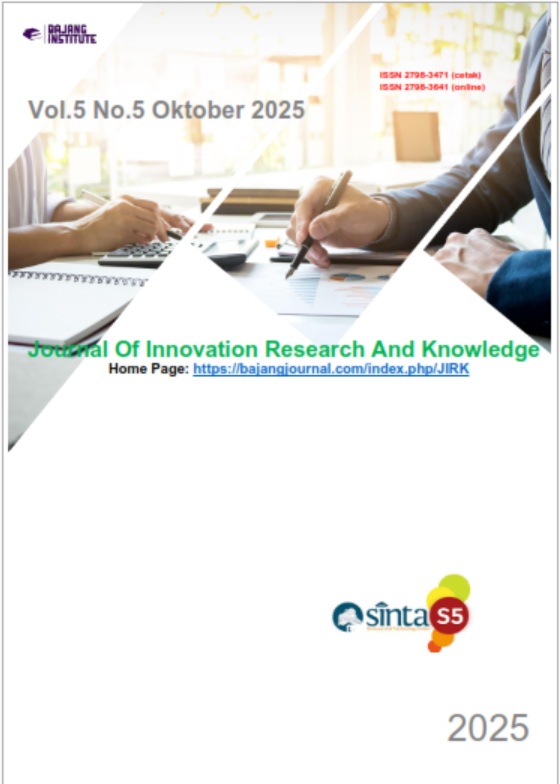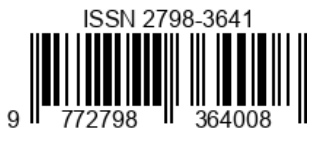IMPULSIVE BUYING GENERASI Z SEBAGAI KONSUMEN E-COMMERCE DITINJAU DARI THE BIG FIVE OF PERSONALITY
Keywords:
Big Five of Personality, E-Commerce, Impulsive Buying, Generation ZAbstract
The growth of e-commerce in the digital era has encouraged the emergence of impulsive buying behavior, particularly among Generation Z who are highly familiar with technology. A preliminary study through questionnaires with 30 respondents and interviews with 10 respondents indicated that individuals aged 18-22 years showed higher impulsivity compared to those aged 13-17 and 23-28 years. This research aims to examine differences in impulsive buying behavior among Generation Z as e-commerce consumers based on the Big Five Personality dimensions (Extraversion, Agreeableness, Conscientiousness, Neuroticism, and Openness to Experience). The study employed a quantitative approach with a comparative design. Sampling was conducted using quota sampling with 100 respondents aged 18-22 years residing in Salatiga, consisting of 77% female and 33% male participants. The instruments used were the Impulsive Buying Scale developed from Rook and Fisher’s theory and the Indonesian version of IPIP-BFM-50 (Akhtar & Azwar, 2018). Data were analyzed using the Kruskal-Wallis test. The findings revealed that only the Agreeableness dimension showed a significant difference in impulsive buying (p = 0.000 < 0.05), whereas Extraversion, Conscientiousness, Neuroticism, and Openness did not show significant differences (p > 0.05). These results indicate that individuals with low Agreeableness levels are more likely to engage in impulsive buying, while the other four personality dimensions did not produce meaningful differences
References
Ahmed, Z., Ramadhan, A., Pangaribuan, C. (2023). The influence of big five personality on impulse buying behavior in online shopping. Journal of Business and Management Science. 1(1), 1-10. https://doi.org/10.61098/jems.v1i1.39
Akhtar, H., & Azwar, S. (2018). Development and validation of a short scale for measuring Big Five personality traits: The IPIP-BFM-25 Indonesia. Journal of Innovation in Psychology, Education, and Didactics, 22, 167-174.
Arikunto, S. (2010). Prosedur penelitian: Suatu pendekatan praktik. PT Asdi Mahasatya. Jakarta.
Arum, L. S., Zahrani, A., & Duha, N. A. (2023). Karakteristik Generasi Z dan kesiapannya dalam menghadapi bonus demografi 2030. Accounting Student Research Journal, 2(1), 59-72.
Cervone, D., Pervin, L. (2022). Personality: Theory and Research: 15 Edition. Wiley Global Education.
Hafiza, Nuril., dkk. (2024). E-commerce memicu maraknya perilaku konsumtif di kalangan mahasiswa Universitas Mataram. Jurnal Dinamika Sosial budaya. 26(1), 24-35.
Hadyan, A., dkk. (2018). Pengaruh tipe kepribadian terhadap impulsive buying pada mahasiswa Psikologi Universitas Esa Unggul yang melakukan pembelian secara online shopping. Jurnal Psikologi, 1-12.
Helmi, Arief., dkk. (2023). The influence of hedonic values and extraversion on online impulse buying: Empirical evidence from Indonesia. Innovative Marketing. 19(1), 48-58. http://dx.doi.org/10.21511/im
IDN Research Institute. (2024). Indonesia gen z report 2024: Understanding and uncovering the behavior, challenges, and opportunities. IDN Media. 71-82.
Florantina, T., Alim, S. (2020). Factors analysis of IPIP-BFM-50 big five personality measurement in Bugis-Makassar culture. Jurnal Ilmiah Ecosystem. 20(2), 156-167. https://journal.unibos.ac.id/eco/article/view/758
Jalees, dkk. (2019). The effects of personality, culture and store stimuli on impulsive buying behavior: Evidence from emerging market of Pakistan. Asia Pacific Journal of Marketing and Logistic. 1(32), 188-204. http://dx.doi.org/10.1108/APJML-09-2018-0377
John, O. P., & Srivastava, S. (1999). The Big-Five trait taxonomy: History, measurement, and theoretical perspectives. In L. A. Pervin & O. P. John (Eds.), Handbook of personality: Theory and research (Vol. 2, pp. 102–138). New York: Guilford Press.
JR, Joseph., dkk. (2010). Multivariate data analysis: Seventh edition. Person, New York.
Khairunnisa, Isyanty., Heriyadi. (2023). Generasi z,pemasaran sosial media, dan perilaku pembelian impulsifnya pada produk fashion. MBIC. 17-29.
Laura, A. King. (2012). The science of psychology: an appreciative view. Salemba Humanika
Mukaromah, M., dkk. (2021). Analisis psikopatologi kecenderungan impulsive buying pada salah satu mahasiswa Universitas Negeri Semarang. Jurnal Ilmiah Psikologi Mind Set. 12(2), 117-124.
Otero-López, J., dkk. (2021). Big five personality traits, coping strategies and compulsive buying in Spanish University students. International of Environmental Research and Public Health. 18(821), 1-15. https://doi.org/10.3390/ijerph18020821
Purwaningtyas, E., dkk. (2025). The big five personality: Agreeableness, conscientiousness, extraversion, neuroticism, openness to experience terhadap impulsive buying behavior pada e-commerce gen z Surabaya. Jurnal LENTERA BISNIS. 14(2), 1250-1266. http://dx.doi.org/10.34127/jrlab.v14i2.1454
Rinonce, E., Jannah, M. (2025). Fear of missing out fuels impulsive buying behavior in gen
z. Psikologia: Jurnal Psikologi. 10(1), 97-110. https://doi:10.21070/psikologia.v10i1.1847n
Sugiyono. (2018). Metode Penelitian kuantitatif, kualitatif, dan R&D. Alfabeta.
Susilawati, E., Wahdiniwaty, R. (2015). Pengaruh kepribadian dan harga terhadap impulse buying pada produk novel di toko buku Bandung Book Center wilayah Bandung. Jurnal Ilmiah Magister Manajemen UNIKOM (JIMM UNIKOM). 1(1), 12-24. https://doi.org/10.34010/jimm.v1i1.201
Utama, N., dkk. (2024). Pengaruh e-commerce terhadap perilaku impulsive buying pada generasi Z. Jurnal Manajemen dan Pemasaran Digital (JMPD). 2(3), 218-226. https://doi.org/10.38035/jmpd.v2i3
Uygur, E. Merdin. (2018). Consumer impulsive buying tendency scale development using mixed methodology.. Beykoz Akademi Dergisi, 6(2), 125–141. https://doi.org/10.14514/BYK.m.26515393. 2018.6/2.125-141
Parengkuan, Erwin. (2017). Understand-inc people: Strategi taktis komunikasi berdasarkan kepribadian. Gramedia Pustaka Utama.
Permana, Sheryl N., Adelina, Ira. (2021). Hubungan trait kepribadian dan impulse buying pada pengguna e-commerce “X”. Jurnal IKRA-ITH Humaniora. 5(1), 1-11.
Purwaningtyas, E., dkk. (2025). The big five personality: Agreeableness, conscientiousness, extraversion, neuroticism, openness to experience terhadap impulsive buying behavior pada e-commerce gen z Surabaya. Jurnal Lentera. 14(2), 1250-1266. https://doi.org?10.34127?jrlab.vl4i2.1454
Putri, Fanny R. C., Artanti, Yessy. (2024). Pembelian impulsif pada marketplace: pengaruh personality, price discount, dan media sosial. SIBATIK JOURNAL. 1(5), 509-522.
Putri, L. S. M., & Komalasari, S. (2023). Dibalik klik: Memahami motif konsumtif Generasi Z di era belanja online dan kebutuhan psikologis yang tidak terpenuhi. Jurnal Psikologi Jambi, 8(2), 1-10.
Putri, M., Ningsih, Y. (2023). Perbedaan impulsive buying ditinjau dari big five of personality pada dewasa awal pengguna e-commerce di Sumatera Barat. Edusociata Jurnal Pendidikan Sosiologi. 6(2), 1512-1519. https://doi.org/10.33627/es.v6i2.1795
Rook, Dennis W., Fisher, Robert J. (1995). Normative Influences on Impulsive Buying Behavior. Journal of Consumer Research. 22, 305-313. http://dx.doi.org/10.1086/209452
Sepetila Rasulika, Aprilia Eka D. (2017). Impulse buying pada manusia di Banda Aceh. Psikoislamedia Jurnal Psikologi. 2(2), 170-182.
Setyanto, Eko., A, Andrine P. A. (2021). Metode Penelitian Komunikasi Kuantitatif. Pustaka Pelajar.
Sokić, Katarina; Korkut, Darija (2020) : The influence of impulsivity and values on impulsive buying, In: Proceedings of the ENTRENOVA - ENTerprise REsearch InNOVAtion Conference, Virtual Conference, 10-12 September 2020, IRENET - Society for Advancing Innovation and Research in Economy, Zagreb, pp. 18-26, https://proceedings.entrenova.org/entrenova/article/view/306
Sujanto, Agus., dkk. (1980). Psikologi kepribadian. Aksara Baru.
Tamara, Yolanda. (2024). The influence of the big 5 personality, financial perceptions, and external factors on impulsive buying tendencies in live streaming. AJESH. 3(7), 1956-19770.
Verplanken, Bas., Herabadi, Astrid G. (2001). Individual Differences in Impulse Buying Tendency: Feeling and No Thinking. European Journal of Personality. 15:71-83. http://dx.doi.org/10.1002/per.423
Badan Pusat Statistik Kota Salatiga. (2024). Jumlah penduduk menurut kelompok umur dan jenis kelamin di Kota Salatiga, 2024. Diakses tanggal 7 Juli 2025, dari https://salatigakota.bps.go.id/id/statistics-table/1/MTQ5MyMx/jumlah-penduduk-men urut-kelompok-umur-dan-jenis-kelamin-di-kota-salatiga-2024.html
Kementerian Keuangan Republik Indonesia, Direktorat Jenderal Kekayaan Negara. (2022). Memanfaatkan e-commerce dengan benar. https://www.djkn.kemenkeu.go.id/artikel/baca/15814/Memanfaatkan-E-commerce-De ngan-Benar.html















